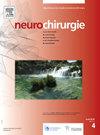Surgical outcomes of ventriculoperitoneal shunts in the Gaza Strip: Insights from a conflict zone and low-resource setting
IF 1.4
4区 医学
Q4 CLINICAL NEUROLOGY
引用次数: 0
Abstract
Background
The Gaza Strip is a low-income, chronically unstable region. This study evaluates the outcomes of first VP shunt placements at the area’s largest tertiary hospital.
Methods
A retrospective study conducted at Shifa Medical Complex in the Gaza Strip examined VP shunts inserted between January 2020 and July 2022. The primary outcome was the shunt failure rates in the first year, while secondary outcomes included the causes of failure and surgical complications. The Chi-square test was used to assess the relationship between risk factors and failure rates. Univariate logistic regression analyzed the link between the duration of post-operative antibiotics and shunt failure rates.
Results
A total of 103 patients were included, with a median age of 11 months. Congenital hydrocephalus accounted for 60.2% of the etiologies. Failure rates were 7.8%, 19.4%, and 26.2% at one, six, and twelve months, respectively. Obstruction and infection were the commonest causes of initial (62.9% and 25.9%) and overall (46.2% and 36.5%) shunt failures. Failure risk increased with elective surgeries, surgeries performed by residents, congenital hydrocephalus, and in the 12-month or younger age group (p < 0.001, p = 0.035, p = 0.02, p < 0.001). Staphylococcus aureus and Staphylococcus epidermidis were the most commonly isolated bacteria. No significant association was found between the duration of postoperative IV antibiotics and the one-year shunt failure rate.
Conclusion
The outcomes of VP shunt surgery at Gaza’s largest tertiary center from 2020 to 2022 aligned with global trends. Prolonged IV antibiotics did not lower revision or complication rates.
加沙地带脑室-腹膜分流术的手术结果:来自冲突地区和低资源环境的见解
加沙地带是一个低收入、长期不稳定的地区。本研究评估了该地区最大的三级医院首次VP分流安置的结果。方法在加沙地带Shifa医疗中心进行的一项回顾性研究检查了2020年1月至2022年7月期间插入的副静脉分流器。主要结果是第一年的分流失败率,而次要结果包括失败的原因和手术并发症。采用卡方检验评估危险因素与失败率之间的关系。单变量logistic回归分析了术后抗生素使用时间与分流管失败率之间的关系。结果共纳入103例患者,中位年龄11个月。先天性脑积水占病因的60.2%。1个月、6个月和12个月的失败率分别为7.8%、19.4%和26.2%。梗阻和感染是最初(62.9%和25.9%)和总体(46.2%和36.5%)分流失败最常见的原因。选择性手术、住院医师手术、先天性脑积水以及12个月及以下年龄组的手术失败风险增加(p <;0.001, p = 0.035, p = 0.02, p <;0.001)。金黄色葡萄球菌和表皮葡萄球菌是最常见的分离细菌。术后静脉抗生素使用时间与1年分流失败率无显著相关性。结论2020年至2022年在加沙最大的三级中心进行副静脉分流手术的结果与全球趋势一致。延长静脉注射抗生素并没有降低翻修率或并发症发生率。
本文章由计算机程序翻译,如有差异,请以英文原文为准。
求助全文
约1分钟内获得全文
求助全文
来源期刊

Neurochirurgie
医学-临床神经学
CiteScore
2.70
自引率
6.20%
发文量
100
审稿时长
29 days
期刊介绍:
Neurochirurgie publishes articles on treatment, teaching and research, neurosurgery training and the professional aspects of our discipline, and also the history and progress of neurosurgery. It focuses on pathologies of the head, spine and central and peripheral nervous systems and their vascularization. All aspects of the specialty are dealt with: trauma, tumor, degenerative disease, infection, vascular pathology, and radiosurgery, and pediatrics. Transversal studies are also welcome: neuroanatomy, neurophysiology, neurology, neuropediatrics, psychiatry, neuropsychology, physical medicine and neurologic rehabilitation, neuro-anesthesia, neurologic intensive care, neuroradiology, functional exploration, neuropathology, neuro-ophthalmology, otoneurology, maxillofacial surgery, neuro-endocrinology and spine surgery. Technical and methodological aspects are also taken onboard: diagnostic and therapeutic techniques, methods for assessing results, epidemiology, surgical, interventional and radiological techniques, simulations and pathophysiological hypotheses, and educational tools. The editorial board may refuse submissions that fail to meet the journal''s aims and scope; such studies will not be peer-reviewed, and the editor in chief will promptly inform the corresponding author, so as not to delay submission to a more suitable journal.
With a view to attracting an international audience of both readers and writers, Neurochirurgie especially welcomes articles in English, and gives priority to original studies. Other kinds of article - reviews, case reports, technical notes and meta-analyses - are equally published.
Every year, a special edition is dedicated to the topic selected by the French Society of Neurosurgery for its annual report.
 求助内容:
求助内容: 应助结果提醒方式:
应助结果提醒方式:


